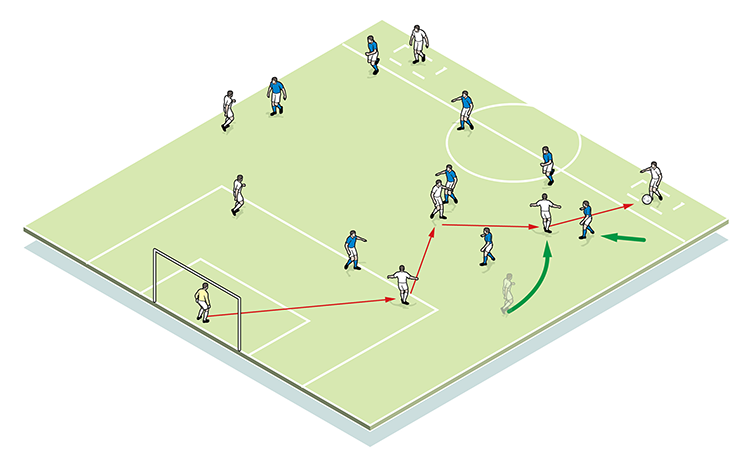




OUR BEST EVER OFFER - SAVE £100/$100
JOIN THE WORLD'S LEADING PROFESSIONAL DEVELOPMENT PROGRAMME
- 12 months membership of Elite Soccer
- Print copy of Elite Player & Coach Development
- Print copy of The Training Ground
Defending against counter-attacks
Defending against the counter-attack and reacting quickly to these transitions of play is important. That’s because in the modern era, once teams win possession they are capable of breaking forward at great speed and with real quality.
| Area | Half pitch plus 10-yard channel past halfway line, in which are two target boxes |
| Equipment | Cones, balls, goals |
| No. of Players | 16: Team 1: 1 keeper, 4 defenders, 1 def mid, 2 target players Team 2: 2 full backs, 2 central mids, 1 attacking mid, 2 wingers, 1 forward |
Defending against the counter-attack and reacting quickly to these transitions of play is important. That’s because in the modern era, once teams win possession they are capable of breaking forward at great speed and with real quality. The ability to make the correct countering defensive decisions is a core part of being a successful defender.
In every match we play we see teams attempt to counter-attack, particularly when they are playing expansive, passing football, or are chasing a game.
We will often flip this session on its head and change the focus so that it is intended for own our attackers when they break forward at pace.
What do I get the players to do?
Play starts from the keeper, with the white team attempting to play forward, working the ball to either of their target players who are fixed in the target boxes past the halfway line. Whites must use their numerical advantage in midfield to play between or over the four defenders on the halfway line.
The blue team uses their fixed line of defenders to remain disciplined in front of the halfway line, screening the two white target players. Their aim is to block the route through to the target players and turn over possession.
If the white team can get the ball to either target man they score a goal and play restarts with the keeper. If blues gain possession of the ball though, all players are free to counter-attack. The white target players are also freed and must attempt to recover quickly, but their isolated position effectively means that blues have an 8v5 counter-attacking overload.
If a blue player scores in the goal, the ball goes out of play, or whites get back to regain possession, the game reverts back to its original shape and play restarts with the keeper.
1

2

3

4

What are the key things to look for technically/tactically?
Defenders must be asking themselves how they can affect the ball, how they drop, delay, apply pressure and recover.
Prioritising the danger is also important – for instance, knowing when to force an attacking player wide and away from goal.
How would you put this into a game situation?
We use a goal at each end of a 70x50 yard area, with a keeper and four defenders taking on three attackers in each half. One midfielder on each team works both halves.
The keeper plays out releasing a defender into the attacking half, creating a 5v5 scenario, including the two midfielders.
On transitions, there is always a 3v3 situation in the defending half plus counter-attacking players, so all the factors worked on come into play in this free-flowing game.
5

6

Related Files
Editor's Picks
Attacking transitions
Deep runs in the final third
Using the goalkeeper in build-up play
Intensive boxes drill with goals
Penetrating the final third
Creating and finishing
My philosophy
Pressing initiation
Compact team movement
Coaches' Testimonials

Alan Pardew

Arsène Wenger

Brendan Rodgers

Carlos Carvalhal

José Mourinho

Jürgen Klopp

Pep Guardiola

Roy Hodgson

Sir Alex Ferguson

Steven Gerrard
Coaches' Testimonials

Gerald Kearney, Downtown Las Vegas Soccer Club

Paul Butler, Florida, USA

Rick Shields, Springboro, USA

Tony Green, Pierrefonds Titans, Quebec, Canada
Join the world's leading coaches and managers and discover for yourself one of the best kept secrets in coaching. No other training tool on the planet is written or read by the calibre of names you’ll find in Elite Soccer.
In a recent survey 92% of subscribers said Elite Soccer makes them more confident, 89% said it makes them a more effective coach and 91% said it makes them more inspired.
Get Monthly Inspiration
All the latest techniques and approaches
Since 2010 Elite Soccer has given subscribers exclusive insight into the training ground practices of the world’s best coaches. Published in partnership with the League Managers Association we have unparalleled access to the leading lights in the English leagues, as well as a host of international managers.
Elite Soccer exclusively features sessions written by the coaches themselves. There are no observed sessions and no sessions “in the style of”, just first-hand advice delivered direct to you from the coach.







